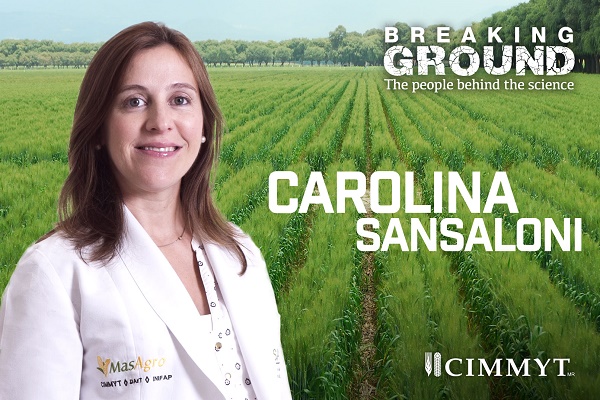
Breaking Ground is a regular series featuring staff at CIMMYT
EL BATAN, Mexico (CIMMYT) – Carolina Sansaloni’s passion for genetics began when she was at Universidad de Misiones in Posadas, Misiones, Argentina, an interest that grew as she moved on to receive her master’s and doctoral degrees in molecular biology at Universidad de Brasilia in Brazil.
While completing her doctorate degree, Sansaloni travelled to Canberra, Australia to research the genomic structure of the eucalyptus tree at Diversity Arrays Technology (DArT), learning the ins and outs of sequencing technology.
In 2012, the International Maize and Wheat Improvement Center (CIMMYT) wanted to introduce the DArT genotyping technologies to Mexico to serve the needs of the Mexican maize and wheat research communities, and once Sansaloni finished her doctoral degree, she was an obvious choice to lead this initiative.
Working under the MasAgro Biodiversidad project in partnership with DArT, INIFAP and CIMMYT, Sansaloni helped to build the Genetic Analysis Service for Agriculture (SAGA in Spanish) from the ground up.
The service, managed by the CIMMYT-based Seeds of Discovery (SeeD) initiative, brings cutting edge genotyping capacity and genetic analysis capability to Mexico. The facility provides unique insights into the genetic variation of wheat and maize at a “sequence level.” Use of the vast quantities of data generated help understand genetic control of characteristics evaluated at a plant or crop level for example, height variations among wheat varieties.
SAGA’s services are available for all CIMMYT scientists, universities, national agriculture research programs and private companies. Worldwide, few other platforms produce this kind of data and most are inaccessible to scientists working at publicly funded institutions because their economic or logistics difficulties.
“When it comes to genotyping technology, it doesn’t matter what type of organism you are working with. It could be wheat, eucalyptus or chicken – the machine will work the same way,” explained Sansaloni.
Sansaloni has also been focusing her time on the wheat Global Diversity Analysis, which characterizes and analyzes seeds in genebanks at both CIMMYT and the International Center for Agricultural Research in Dry Areas (ICARDA). Her team has characterized approximately 100,000 wheat accessions including 40 percent of the CIMMYT genebank and almost 100 percent of the ICARDA genebank wheat collection. This is an incredible and unique resource for wheat scientists providing a genetic framework to facilitate selection of the most relevant accessions for breeding.
“Currently only five to eight percent of materials in the genebank are being used in the breeding programs,” Sansaloni said. “The Global Diversity Analysis could have huge impacts on the future of wheat yields. It is like discovering the pieces of a puzzle, and then beginning to understand how these pieces can fit together to build excellent varieties of wheat.”
Sansaloni’s goal is to combine information from CIMMYT and ICARDA, making the information accessible to the entire wheat community and eventually enhancing breeding programs across the globe.
“Working at CIMMYT has been an invaluable experience,” Sansaloni said. “I’ve had the opportunity to work and collaborate with so many different people, and it’s brought me from the laboratory into the wheat fields, which really brings me closer to my work.”
SeeD is a joint initiative of CIMMYT and the Mexican Ministry of Agriculture (SAGARPA) through the MasAgro project. SeeD receives additional funding from the CGIAR Research Programs on Maize (MAIZE CRP) and Wheat (WHEAT CRP), and from the UK’s Biotechnology and Biological Sciences Research Council (BBSRC).
 Innovations
Innovations